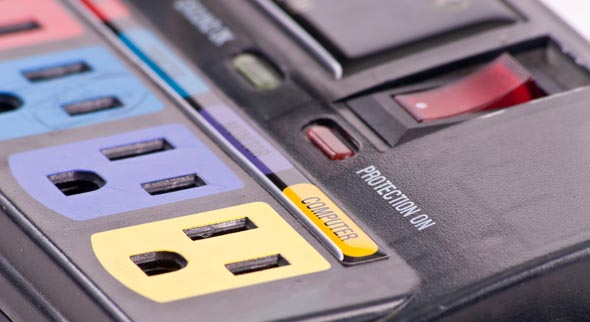Surge Protector Help for Your Massage Chair
When to Use a Surge Protector
So what causes an electrical surge? Most people think that the main culprit of electrical surging is lightning, but that’s not true at all. Yes, lightning can and does cause electrical surges, but the voltage of lightning is so great that most surge protectors won’t be able to withstand their power. During a lightning storm, the only way to be absolutely sure that your devices won’t be surged is to unplug them.
The main culprit of electrical surges? Electrical devices that require lots of power to operate. Depending on the wiring of your home, you may notice at times that your lights flicker when powerful devices turn on and off, e.g. your air conditioner. When these devices are switched on, they demand a lot of electricity, which puts a lot of strain on the grid and can cause surges.
When should you use a surge protector? All the time. The real question is really which devices you should connect to a surge protector. You don’t need a surge protector for your desk lamp or your standing fan, but you do want a surge protector for expensive devices that have intricate microprocessors, like computers, televisions, stereo systems, media centers, high-tech kitchen appliances, etc.What Is A CPU and What Does It Do? [Technology Explained] What Is A CPU and What Does It Do? [Technology Explained]READ MORE
Think of it this way: if there was an electrical surge that destroyed all of the devices connected to your outlets, which lost devices would pain you the most? Plug those into a surge protector. It’s better to be safe than sorry.
On an offbeat note, surge protectors can be useful for reducing cable clutter and improving organization with your electronics. All of the cables end up being directed to the same destination, making it much easier for you to handle them all neatly.
Choosing the Right Surge Protector
It can be difficult finding the right surge protector for your needs at a good value, mostly because people don’t talk about it very often. What makes a surge protector good? And why are some surge protectors much more expensive than others? Are there any features you should be looking out for?

The first thing you’ll want is an indicator light. Do not compromise on this. Surge protectors will not last forever – in fact, even when the surge protector properly diverts a surge so your electronics aren’t damaged, the protector itself can be damaged in the process. An indicator light will let you know that your surge protector is working fine. Is the indicator light not working? Time to buy a new surge protector.
As for protection power, good surge protectors will come with a UL rating, a rating put out by the independent Underwriters Laboratories that tests the safety of electronic devices. Don’t bother with a surge protector that doesn’t have a UL rating. Also make sure that the product is a “transient voltage surge suppressor” as many UL-rated power strips still might not offer surge protection.
And there are a few other considerations to make:
- Clamping voltage is the voltage measurement that prompts the surge protector to start redirecting the excess electricity away from the plugged-in devices. In other words, a surge protector will a lower clamping voltage will trigger earlier, thus better protecting your devices. Any surge protector with a clamping voltage below 400 volts should be good enough for home use.
- Joule rating is the maximum amount of energy the surge protector can absorb. If the surge breaches this maximum, the surge protector will be rendered useless. The higher the joule rating, the more energy can be absorbed by the surge protector, so a higher joule rating will often indicate a longer lifespan for the product. For best household protection, you’ll want a surge protector with a joule rating of at least 600.
- Response time is how long it takes for the surge protector to detect a surge in electricity. A lower response time means a faster response time, which reduces the time that your plugged-in devices are exposed to the surge, thus protecting them better. Ideally, you’ll want a surge protector with a response time of 1 nanosecond or faster.
Recommended Surge Protectors
If you need some help getting started with finding a good surge protector, here are some that I recommend. All of these have a UL rating of 1449, which is what you should be looking for:
- Maruson SUG-B706NT ($20): A strong 7-outlet surge protector with indicator lights, a clamping voltage of 330V, a joule rating of 720, and a response time below 1 nanosecond. Perfect for an everyday household.
- Tripp Lite TLP606 ($10): Another strong surge protector with 6 outlets, an indicator light, a clamping voltage of 150V, a joule rating of 790, and a response time below 1 nanosecond.
- Tripp Lite SPIKECUBE ($6): Here’s an interesting surge protector with only 1 outlet. It has two indicator lights – one for grounded, one for protected. It has a clamping voltage of 150V, a joule rating of 600, and a response time below 1 nanosecond.
Conclusion
The take away? All electrical grids experience electrical surges, some more than others. These surges can damage electronics and surge protectors are there to keep those surges under control as much as possible. You’ll want to use surge protectors for complex and valuable electronics, such as computers, appliances, and media centers. Keep in mind that it’s not enough to have a surge protector; you need one that’s properly rated for your needs.

